With all the crazy weather happening recently in the North Pacific (hurricanes, tsunami warnings, storms in Vancouver, etc), we’ve been reminiscing about some of the mad weather related moments on Illusion’s journey from New Zealand to Hawaii. Here are a few of the memories that stand out, for varying reasons…
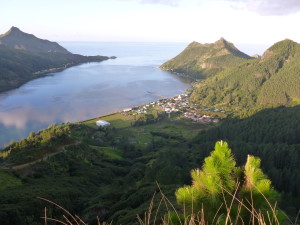
Heading to Rapa: This was the worst passage Illusion ever experienced! Three large storms in the five weeks at sea, and all were head winds. The first was a low that was predicted to pass to the southeast ahead of us, which meant that if we were close enough, we’d pick up following winds and ride them for a while… Instead, it moved east and a bit north, so we pounded into 3 meter seas (10 feet) for almost a week. After a couple days of calm, an Antarctic front crashed into a stationary high that had peeled off of the South American high and created a “squash zone” directly over us.
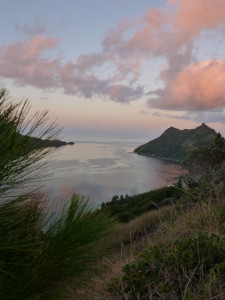
We struggled on through 6+ meter seas and 60+ knots for about 5 days. Illusion held up fine, but we were all exhausted and eventually turned downwind with no sails (“bare poles”) until the squash zone cleared. After that, the third storm wasn’t too big a deal. Apart from the last night before landfall, we never got any other form of downwind sailing in the whole five week journey.
Anchored at Rapa, it still felt like we were at sea. The island’s unique land form means the wind only blows from the east or the west, but it almost always blows double the prevailing conditions in the surrounding ocean. One and a half meter seas and 25-35 knot winds were common inside the anchorage; one storm brought 45 knot winds. Not a restful place to be on a boat!
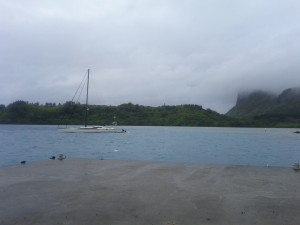
On Raivavae: The second night Sara spent on Illusion it got stormy and our anchor dragged, (it’s hard to set an anchor well without an engine!) leaving us speeding towards the rocky shore at 3am. Doug and Anton, from the other boat in the bay, raced around on dinghies, setting a second anchor for our boat. This photo shows our position the following morning, a lot closer to land than when we’d gone to bed the night before!
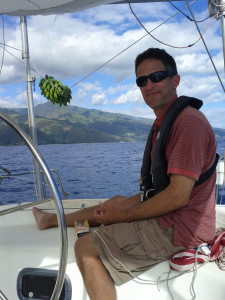 Heading to Tahiti: We’d made really fast progress up to Tahiti from Raivavae and had been watching the island ahead of us, from first light, excited to be getting close. We got close! And then found ourselves in the island’s wind shadow. Where were spent many hours, trying to pick up a little wind to get to the marina. We were down to 0 knots and were going backwards at times (again, if only we’d had an engine…!) Here’s Doug enjoying a picnic of canned sardines and crackers shortly after taking a nap – waking up to find us in almost exactly the same spot.
Heading to Tahiti: We’d made really fast progress up to Tahiti from Raivavae and had been watching the island ahead of us, from first light, excited to be getting close. We got close! And then found ourselves in the island’s wind shadow. Where were spent many hours, trying to pick up a little wind to get to the marina. We were down to 0 knots and were going backwards at times (again, if only we’d had an engine…!) Here’s Doug enjoying a picnic of canned sardines and crackers shortly after taking a nap – waking up to find us in almost exactly the same spot.
En route from Tahiti to Nuku Hiva: We had been making good speedy progress, and were looking forward to making landfall in great time and having a few days to explore Nuku Hiva before Janice and Sara both had to fly off to other commitments, when suddenly, there was no wind! It was nice at first, chilling out, enjoying the sunshine, taking it easy. But after a while we just wanted to get moving…
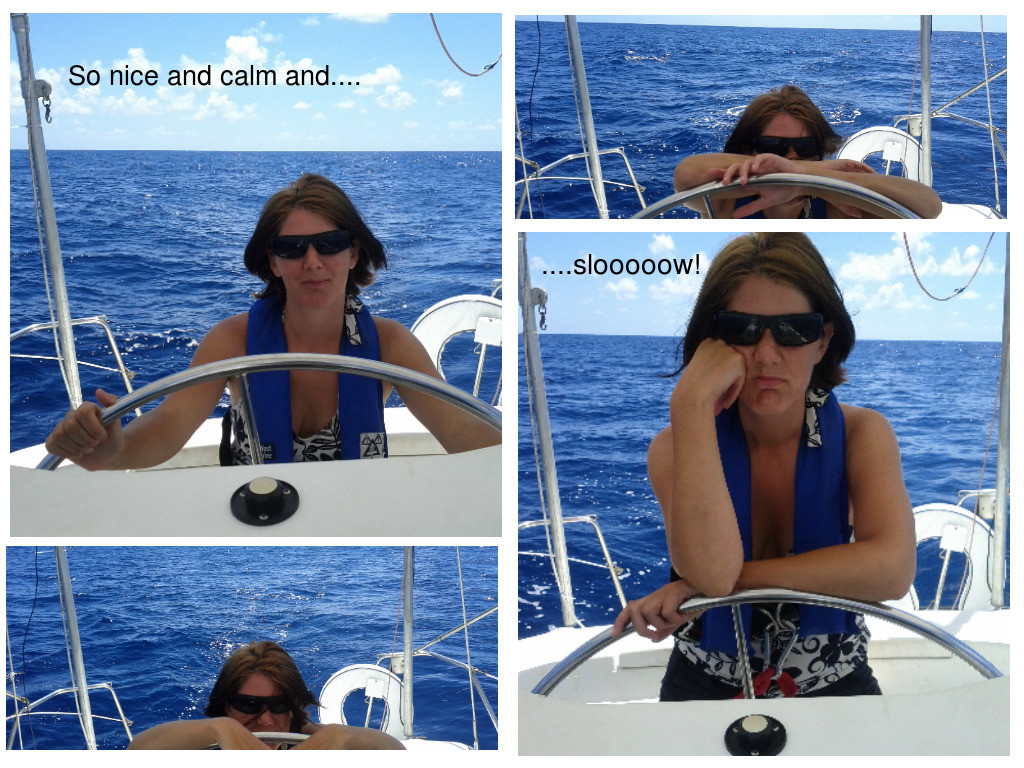 Before too long we were rewarded with some variation – we watched squalls ahead of us and wondered whether we would get any rain. We did. And though we’d been watching the grey up ahead for a bit, it still came quicker than expected: “Quick, close the hatches! NOW!!!” It was pretty cool, actually – lasted just long enough to give Sara a really good shower and clean the salt out of clothes, and not so long that it got too cold. The others hid out below deck, popping up occasionally to check all was ok (well, to laugh and take photos mainly)….
Before too long we were rewarded with some variation – we watched squalls ahead of us and wondered whether we would get any rain. We did. And though we’d been watching the grey up ahead for a bit, it still came quicker than expected: “Quick, close the hatches! NOW!!!” It was pretty cool, actually – lasted just long enough to give Sara a really good shower and clean the salt out of clothes, and not so long that it got too cold. The others hid out below deck, popping up occasionally to check all was ok (well, to laugh and take photos mainly)….
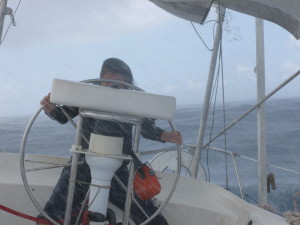
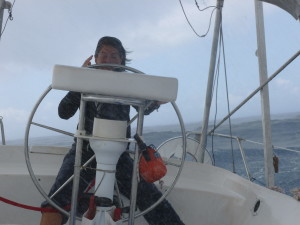
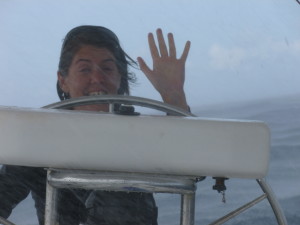 Afterwards, we found loads of tiny flying fish who’d ended up in our cockpit and all over the deck.
Afterwards, we found loads of tiny flying fish who’d ended up in our cockpit and all over the deck.
Heading to Hawaii: The passage from French Polynesia to Hawaii had reasonably calm weather, except the usual Intertropical Convergence Zone (ITCZ) squalls. Some were bigger than others and, true to form, the last one the ITCZ threw at Illusion was the biggest. Just as sunset was approaching, a line appeared on the southeast horizon, stretching from the east to the southwest. It hit Illusion full force about 10pm that night and Doug hand steered through the heaviest of the storm, surfing with the storm consistently at 13 to 15.5 knots for well over 3 hours.
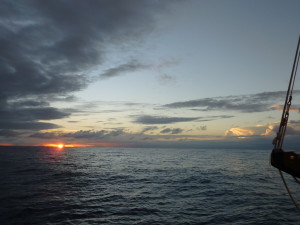

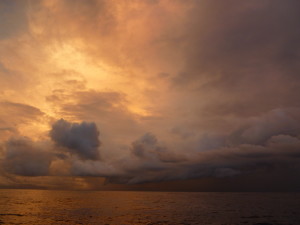
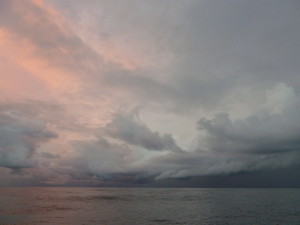 It’s cool, looking back, to realize some of the most magical, dramatic, memorable moments are connected to extreme weather in some form – clouds always make the sunset more magical, rain is always welcome after long hot salty days.
It’s cool, looking back, to realize some of the most magical, dramatic, memorable moments are connected to extreme weather in some form – clouds always make the sunset more magical, rain is always welcome after long hot salty days.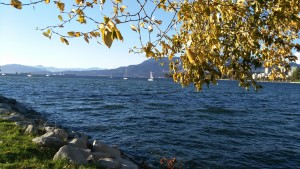 Now Autumn has definitely arrived in Vancouver we’re enjoying feeling the chill in the air, watching the leaves change and the type of sunlight that only comes on these glowing Fall days. Today on a walk along the beach we watched the waves going wild with the wind and the boats pulling at their anchor lines.There were a couple of little boats that had ended up on the rocks. A reminder that, even close to shore, sometimes especially close to shore, weather can make or break the sailing experience. Fair winds, sailing friends!
Now Autumn has definitely arrived in Vancouver we’re enjoying feeling the chill in the air, watching the leaves change and the type of sunlight that only comes on these glowing Fall days. Today on a walk along the beach we watched the waves going wild with the wind and the boats pulling at their anchor lines.There were a couple of little boats that had ended up on the rocks. A reminder that, even close to shore, sometimes especially close to shore, weather can make or break the sailing experience. Fair winds, sailing friends!
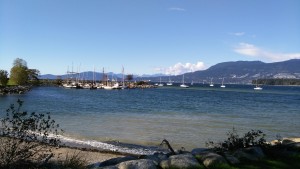
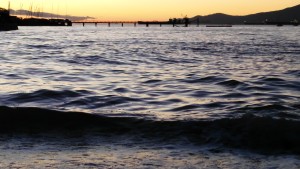
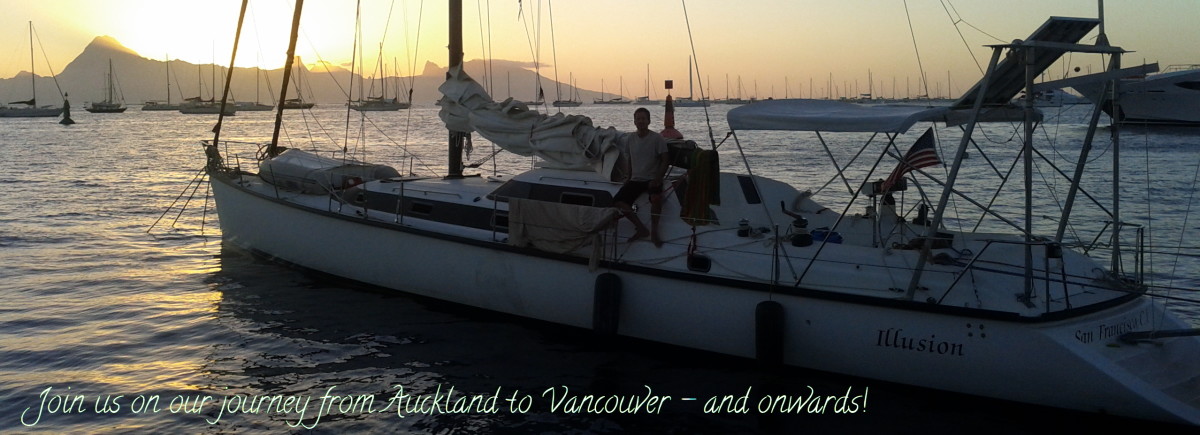
Please describe best practice on the M65 in high wind & large seas. The Mac65 downwind, seems like it would surf steadily, staying on 1 wave for long periods of time. Would this be dangerous to do for long?
I’ve heard it handles better than most boat due it its long lwaterline & narrow beam.
What about going upwind in huge waves? Does the bow bury very easily?
Hi Pat,
Good questions! When I left San Francisco (mid-90s), we were in 30-35 knot winds, going almost directly downwind in 12-14 foot (3.5 to 4m) seas. We surfed under autopilot control the whole day, doing 18+ knots riding a wave; every couple minutes or so we’d lose that wave, slow to 9 knots on the back side of it, then pick up the next one about 20 seconds later. It was surprisingly comfortable (& easy with the autopilot!) – the downwind speed reduced our apparent wind, improving our cold, early-winter, blustery day to balmy t-shirt weather.
The trip from NZ to Rapa Iti was almost 20 years later and the autopilot needed a little underway repair work, but served us well for the 60+ knot winds. Going upwind in a storm is not fun, but we did that for almost the entire 35 days. Upwind, the bow certainly gets wet in big seas, but pops back on top of the water very quickly – not much water aft of the mast, only occasional spray in the pilothouse windows. Our downwind experience then was going the wrong direction (we all needed a break so went downwind to “rest”), so we went for “no-sails” and didn’t really surf much. I was outside near the transom tying down some gear during part of that and never felt that I would get wet from a wave, though there was lots of needle-like, stinging spray.
I think the advantage of the MacGregor 65 in large seas is that she tends to pick up speed (up- or downwind), which gives the rudder a much stronger turning moment, so she’s very responsive, even at 26.5 knots (my top speed!). Many others tell me that their boat tends to lose steerage above hull speed, which would certainly make storm conditions more dangerous.
I hope this answers your questions,
Doug